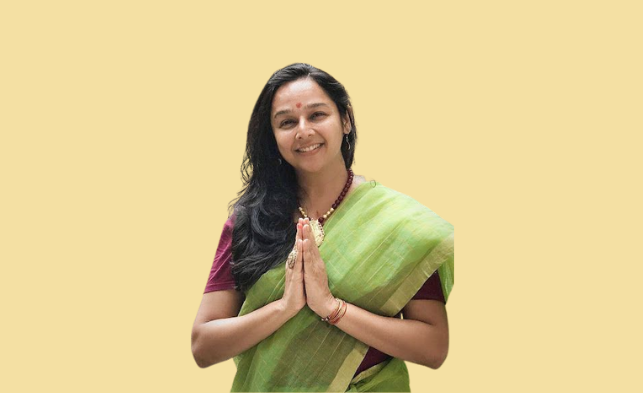The founder of Pragya Yoga, Sujata Collage, speaks nine languages, has lived in five countries, and she believes the universal applicability of yoga can benefit the east and the west. “I find that in eastern spiritual traditions, the practices are potent as techniques are flawless and there is strong scriptural backing to the values that people live by. In the west, a sense of curiosity is encouraged, I admire the scientific evidence-based research approach, presentation skills, and ability to communicate nuanced teaching with articulation. I have a deep respect for both approaches and we can imbibe a lot from both,” says Sujata. Her liberal approach to yoga allows her to offer students what they specifically need and she feels when it comes to finding inspiration to practise, we can learn a lot from children…
Sophia: You speak nine languages and have lived in over five countries. Your spiritual pursuits are inspired by Sanātana Dharma, Buddhism and Yoga/Sankya. How do you combine these different (and at times opposing) schools to arrive at your own unique method of teaching yoga and spiritual practices?
Sujata: As human beings, we are all similar, what motivates us; qualities like love, happiness, and kindness are universal regardless of where we live and what our beliefs are. Similarly, the challenges we face internally and externally are common to all. Emotions such as aggression, greed, grief and the physical manifestation of imbalances in the form of illness are prevalent regardless of cultural or geographical boundaries. The teachings, no matter the labels we give them, point to the alleviation of suffering and give us methods to live to our highest potential. I have been very fortunate to have great teachers from various traditions, each has enriched my personal understanding and practice, and in turn, my ability to share this with others. Depending on the situation, different techniques can be applied effectively. Yoga is this broad, open, all-embracing space for me. The Rig Ved encapsulates it best in, “ Let noble thoughts come to me from all directions.” All teachings invite us to explore our inner nature, practice, and find our own peace.
Sophia: Tell us about children’s yoga. What is the correct age for children to start learning and how do you simplify complex yogic wisdom so even a child can understand?
Sujata: Children, in general, are flexible, playful and receptive to yoga. Their minds are sharp and they speak the truth from their heart without fear. Children tend to absorb more and are very sensitive and wise because they tend to have fewer preconceived notions. When teaching children, I include games, activities and stories in the classes. In this pedagogical approach, they understand concepts easily and often come up with very creative ways of expressing their learnings. When children can understand instructions and respond to them, they are ready to start yoga. Very young children should not practice pranayama and some other practices as their bodies are not fully developed.
Sophia: You conduct corporate yoga workshops. How does yoga help increase productivity at the workplace?
Sujata: Levels of stress at work due to demands on time are ever-increasing. People are busy at home and at work. We often hear of burnout due to work pressure. In the last couple of years of the pandemic with the work-from-home model, people were always “on-call,” and there were no clear boundaries about a “switch off” time. In this context, yoga and wellness workshops at the workspace help immensely. We help curate and design programs along with training and HR teams in companies aimed at improving coping mechanisms, managing anxiety and insomnia, reducing stress and helping foster a sense of team spirit. Be it mindfulness, chair yoga, or immunity-boosting; these workshops and retreats enhance levels of focus and promote wellbeing. Breathing techniques, practical exercises and guided relaxation are tools to reset and rejuvenate and improve sharpness and productivity at the workplace.
Sophia: Asana, Pranayama, Ayurveda, Meditation, Philosophy — is it essential to practise all of these for a holistic experience of yoga?
Sujata: Like a beautiful diamond with many facets where each facet is reflected in another enhancing its beauty and adding to the brilliance, these aspects help our understanding and experience of yoga. All these may seem different but are interconnected and allied. Asana without attention to the breath is mere contortion, pranayama and meditation require some stability in a chosen asana so they are closely linked. Students may often pick one, then go on to practise others for an integrated and holistic experience. Ayurveda is a sister science and there are many guidelines on diet, nutrition and lifestyle that are immensely beneficial to anyone on this path. The study of philosophy presents different perspectives to shape our worldview. However, having a very scholarly understanding of Philosophy or Yoga is not important in my view, these are practical and experiential areas. Someone with disabilities may not be able to practise asana but can easily experience yoga through other aspects. Those on the path of bhakti yoga, may need none of these! So the bottomline as Sri Aurobindo eloquently teaches is that all life is yoga.
Sophia: You’ve addressed the issues of injuries in one of your blog posts. While it’s true that injuries can teach a lot, how can students and teachers differentiate between an injury that happens naturally or as an accident, and injuries that happen deliberately because students are practising incorrectly or teachers are being too pushy?
Sujata: Most injuries occur due to a lapse in awareness, be it going beyond what is within the range of physical capacity, trying to rush through practice, or not being ready for a certain practice. A sharp pain is a very different experience from the movement of muscles during practice. Foundational alignment and clarity of instruction are very important to prevent injuries. One of the cornerstones of ashtanga yoga is ahimsa or nonviolence. Apart from its obvious meaning, within the practice, it means not hurting oneself or others on and off the mat. Another cornerstone is santosha or contentment. An example I would like to share is paschimottanasana (the seated forward bend) we can enjoy sukha or happiness and experience a sense of calmness in this asana when we practice it properly as per the instructor of a qualified teacher but if we become aggressive about reaching our toes we might injure ourselves. As the saying goes, it is not important to touch our toes but what we learn on the journey there!
For teachers, there are three points to consider. The first is knowing the technique and safety protocols thoroughly, the second is to understand the student’s ability and physical and mental limitations, and the third and most important is compassion in teaching. Compassion might mean not teaching a particular asana to a student. So clarity and confidence to express it are also necessary.
Sophia: With yoga becoming so global and gaining popularity, how can authentic yoga teachers ensure that the essence of this practice is not diluted in all the translation?
Sujata: It is sad to see yoga being reduced to contortionism and its teaching confined to only asana as its popularity grows globally. Teachers can do much more in this regard to share not just one aspect of yoga, but present it in its complete and whole form. The metaphors may change with geographical and cultural boundaries but the essence remains the same. Yoga is much much more than asana alone, it is the most sophisticated technology to harness our vital energy – our prana.
Sophia: What are you reading right now and can you list some of your favourite books on spirituality?
Sujata: My current reading is focused on classical yoga texts and current academic research in the area of antenatal health and the effect yoga and integrative medicine have on pregnancy and delivery outcomes.
My favourite are classics: Upanishads, Bhagavad Gita, Dhammapada, Yoga Sutras, Hatha Yoga Pradipika, Light on Yoga (BKS Iyengar), The yoga tradition (Georg Feuerstein)
Here are others books I like:
- Cave in the Snow by Vicki Mackenzie. It is about the incredible and inspiring life story of Ven Tenzin Palmo, who spent 12 years alone in a cave and is a champion of women on the spiritual path.
- Health, Healing and Beyond: Yoga and the living tradition of Krishnamacharya by TKV Desikachar, and RH Cravens
- Meditation in Action by Chogyam Trungpa Rinpoche. A simple short book that is direct and helps cut through trappings of the mind in a lovely way.
- Moving into stillness by Erich Schifmann. This book explains basic asanas with clarity and modifications. Lots of photographs and a journey into the author’s own experiences.
- The five Tibetans by Christopher Kilham. This contains a set of five practices to maintain good health and vitality.
Sophia: Your advice to yoga practitioners who want to change their practice into a teaching career?
Sujata: Sharing what you know well and enjoy doing is a wonderful and noble thing to consider as a career. Top three suggestions that come to mind are undergoing a rigorous training or apprenticeship program to become competent – here is where you learn the technical aspects and gain a solid foundation in subjects like functional anatomy and physiology, Sanskrit, philosophy, and so on. Secondly, finding time to continue your own sadhana and practice – when you start teaching your own practice often suffers so it is important to safeguard that. Lastly, there are financial and practical considerations when you think of building a career. Speak to your mentors, try it part-time and see if this is what you really want. Teaching is a responsibility and it is a lot of hard work, one must be physically and mentally prepared for it. If there is authenticity in your heart and voice, then as the yoga saying goes “when the teacher is ready the student appears”!
Sophia: As you’ve lived in Eastern and Western cultures, what do you think the East can learn from the West and vice versa?
Sujata: It has been a privilege and a blessing to have lived, learned, and taught in the east and the west. I find that in eastern spiritual traditions, the practices are potent as techniques are flawless and there is strong scriptural backing to the values that people live by. In the west, a sense of curiosity is encouraged, I admire the scientific evidence-based research approach, presentation skills, and ability to communicate nuanced teaching with articulation. I have a deep respect for both approaches and we can imbibe a lot from both.
Sophia: What can children teach us about yoga?
Sujata: Children teach us to be flexible, playful and enjoy every moment in the here and now. They have a sense of finding happiness in small things. They are not afraid to try out new things. For example, a lot of adults find it difficult to do inversions and more often than not, it is a mental block. Children, on the other hand, easily get into a handstand because they are unafraid. They are quick to learn, are enthusiastic and will tell you straight away how they feel. This authentic self-expression is something we can all learn from.
For more information on Sujata’s work, visit Pragya Yoga.





